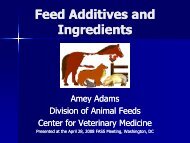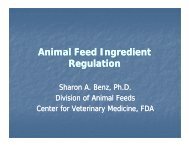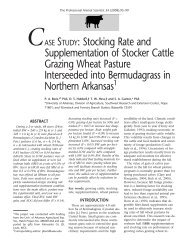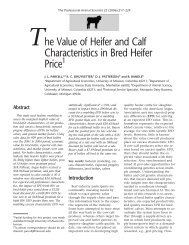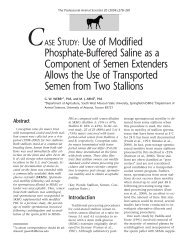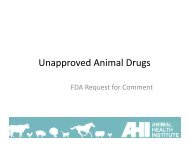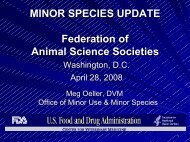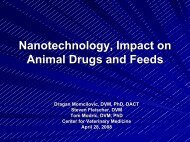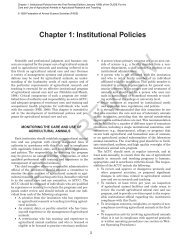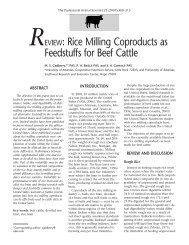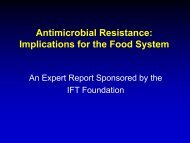FAIR 2012• Key topic 1-1: Feed efficiency: Includes nutritionaland management factors affecting the efficiency <strong>of</strong> feed utilizationin farm animals, encompassing the full life cycle;considers measurement <strong>of</strong> dietary energy, factors affectingdigestibility such as feed processing and use <strong>of</strong> exogenousenzymes, and other items.• Key topic 1-2: Energetic efficiency: Includesgenetic and other factors affecting energetic efficiency inanimal tissues.• Key topic 1-3: Connecting “–omics” to animalproduction: Includes functional genomics, proteomics,metabolomics, epigenetics, and their practical applicationsin animal production.• Key topic 1-4: Reproductive efficiencyFocus Area 2: One HealthWith increases in globalization, the intersection between animal andhuman health continues to become more and more complex. TheOne Health concept has evolved in recent years in response to theseincreased complexities. In its broadest sense, One Health addresses factorsaffecting animal health, human health, ecological health, and theirinterconnections, using an interdisciplinary approach. One example<strong>of</strong> these interconnections is the impact <strong>of</strong> zoonotic diseases. Zoonoses(diseases that can be passed between animals and humans) are <strong>of</strong>tendiseases <strong>of</strong> major economic and public health importance and accountfor 58% <strong>of</strong> currently recognized human pathogens. Of the annuallyemerging zoonotic infectious disease events, domestic animals accountfor about 20%. Further complicating this situation is the fact that,in both developed and developing countries, people share their homeenvironments with a variety <strong>of</strong> animal species, ranging from companionanimals to livestock. Poor sanitation and hygiene conditions leadto frequent exposure <strong>of</strong> humans to animal pathogens and vice versa.The intersection <strong>of</strong> human and animal health is also fertile groundfor policy and regulatory challenges. For example, the use <strong>of</strong> antibioticsin animal agriculture has been the source <strong>of</strong> much controversyin recent years as critics express concerns about antimicrobialresistance. Investments in research will be essential to more clearlyunderstand these issues and provide decision makers with sciencebasedinformation to develop better-informed policies.Sound nutrition is another critical aspect to disease prevention andimproving human and animal health. The importance <strong>of</strong> good nutritionis central to preventing disease, correcting physiological imbalances,and providing needed energy. Healthier animals also provide saferand more wholesome products for human consumption. Advances inthe animal sciences can play a major role in promoting the One Healthconcept, resulting in healthier humans, animals, and the environment.• Key topic 2-1: New approaches to vaccinedevelopment• Key topic 2-2: Understanding and controllingzoonoses• Key topic 2-3: Improving animal health throughfeed: Includes feed additives, feed ingredients, andother aspects <strong>of</strong> feed that may influence immune function,microbiota <strong>of</strong> the digestive tract, and animal health.• Key topic 2-4: Improving food safety throughdisease control and prevention• Key topic 2-5: Enhancing nutritional value <strong>of</strong>animal food products to meet human nutrientrequirementsFocus Area 3: Stewardship<strong>Animal</strong> agriculture touches many aspects <strong>of</strong> our society: providingessential nutrition, balancing natural resources, and fostering animalwell-being. In order to meet global food demands in a sustainableway, investments in science will be critical to increasing the efficiencywith which limited natural resources are utilized. Water qualityand quantity are major issues, as competition for this preciousresource intensifies. Society also continues to have concerns aboutclimate change and the impacts that animal production may haveon climate. These factors demonstrate the need for increased investmentsin science.Great successes in resource use efficiency have already been realizedthrough technological innovations. For example, in analyzingthe life cycle <strong>of</strong> beef production between 1977 and 2009, the sameamount <strong>of</strong> beef can now be produced with 10% less feed energy,20% less feedstuffs, 30% less land, 14% less water, and 9% less fossilfuel energy. Improvements in production systems have also led toan 18% decrease in total carbon emissions. In light <strong>of</strong> the need todouble food production by 2050, science must keep pace with populationgrowth to make even greater strides in resource utilization.Another important factor <strong>of</strong> stewardship is animal well-being.Critics <strong>of</strong> animal agriculture continue to raise concerns about theeffects that production systems and increased production capacityhave on the well-being <strong>of</strong> farm animals. Housing systems for farmanimals are evolving in response to societal concerns and marketdemands. Standards for housing and production systems must bebased in sound science, and investments are needed to better understandthese issues.• Key topic 3-1: Estimation and reduction <strong>of</strong>greenhouse gas production: Includes refinement<strong>of</strong> estimation <strong>of</strong> the carbon footprint <strong>of</strong> animal productionsystems, rumen function, efficiency <strong>of</strong> feed use, productionsystems and other items.• Key topic 3-2: Flow <strong>of</strong> nutrients and otherpotential pollutants from animal productionsystems: Includes quantification within an animal productionsystem, but also extended to whole farm systemsincluding crop/forage production; and post-harvest.• Key topic 3-3: Effects <strong>of</strong> housing systems onanimal well-being14
FAIR 2012Crosscutting IssuesIncreased investments in the priority areas identified by FAIR2012 will be critical for the animal sciences and animal agricultureto successfully meet the challenges <strong>of</strong> Food Security, One Health,and Stewardship. However, increased investment alone will not beenough. A number <strong>of</strong> crosscutting issues must also be addressed tohelp ensure success:Balanced Portfolio – One <strong>of</strong> the strengths <strong>of</strong> the US agriculturalsystem is the “three-legged stool” <strong>of</strong> research, education, andextension. It is critical that this balanced approach be maintained.Support for research should span from fundamental to applied, withadequate resources dedicated to the extension <strong>of</strong> these technologiesinto the field. It is also important to maintain the capacity <strong>of</strong> bothintramural and extramural programs. The educational componentmust not be neglected because the success <strong>of</strong> animal agriculturedepends on a robust pipeline to develop new scientists, producers,and industry pr<strong>of</strong>essionals.Size and Scope <strong>of</strong> Projects – A current trend at the USDAis to fund large, multi-institutional grants over extended periods.Although there is value in these large awards, it is important tomaintain a balance in the size and scope <strong>of</strong> projects. Without suchbalance, there is a risk that research driven by single investigators ornew investigators will be neglected because <strong>of</strong> inadequate resources.This could have the unintended consequence <strong>of</strong> driving new scientistsaway from agriculture, further jeopardizing the development <strong>of</strong>new leaders in the animal sciences.Enhanced Collaborations – Enhanced collaborations on issuesimportant to the animal sciences can play an important role in meetingfuture challenges. The USDA, universities, and others shouldincrease links with federal research agencies such as the NationalInstitutes <strong>of</strong> Health, National <strong>Science</strong> Foundation, Department <strong>of</strong>Energy, and others to leverage limited resources and drive innovation.Increased Public Awareness – <strong>Animal</strong> agriculture suffersfrom a perception problem. A critical need exists to better informconsumers about the importance <strong>of</strong> farm animal production and thevalue <strong>of</strong> agricultural research.Regulations – The issues surrounding animal agriculture arefertile ground for regulations, including issues related to the environment,animal drugs, and trade. The future success <strong>of</strong> animal agriculturewill depend on the consistent and predictable use <strong>of</strong> soundscience by policy makers.Data Mining – As research priorities are set and agendas developed,it is important that comprehensive mining <strong>of</strong> historical databe conducted, to understand what is already known, to preventunnecessary duplication, and to provide a better base on which tobuild future research. Data mining will reveal information that canbe converted into knowledge about historical research, and thesedata can be used to predict future trends to be used in research planningto support guidelines and policies.ConclusionsOne hundred and fifty years after the creation <strong>of</strong> the United StatesDepartment <strong>of</strong> Agriculture, the agricultural research, extension, andeducation system has many successes <strong>of</strong> which to be proud. Lookingahead, scientific achievements in the areas <strong>of</strong> Food Security, OneHealth, and Stewardship will likely be the areas by which success <strong>of</strong>the animal sciences will be measured. Increased public investment inthe priorities identified by FAIR 2012 will be important in feedingan increasing global population in a way that maximizes the efficientuse <strong>of</strong> limited resources and promotes human, animal, and ecologicalhealth. To achieve the greatest impact <strong>of</strong> these investments, attentionmust be paid to crosscutting issues related to the structure <strong>of</strong>research programs, enhanced collaborations, science-based policies,and increased public awareness <strong>of</strong> the importance <strong>of</strong> animal agricultureand the role <strong>of</strong> science. There is no doubt that the challengesfacing animal agriculture in the future will be significant but, withwise investments in science, success is achievable.15



